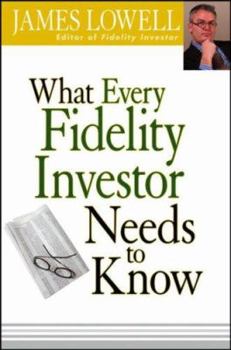What Every Fidelity Investor Needs to Know
Fidelity offers investors some of the most innovative financial tools, products, and platforms currently available, and with What Every Fidelity Investor Needs to Know, James Lowell--one of the most... This description may be from another edition of this product.
Format:Hardcover
Language:English
ISBN:0470036273
ISBN13:9780470036273
Release Date:November 2006
Publisher:Wiley
Length:338 Pages
Weight:1.70 lbs.
Dimensions:1.2" x 6.3" x 9.3"
Customer Reviews
2 ratings
Lowell's latest FIDO Book
Published by Thriftbooks.com User , 17 years ago
Informative Writings with good data & thoughful analysis. Charts & Graph while readable the font size is too small.
Comprehensive Review of Fidelity Funds
Published by Thriftbooks.com User , 17 years ago
James Lowell has spent many years analyzing Fidelity funds for his well-known website and newsletter. In this 338-page, twenty chapter book, the author tells you everything you ever wanted to know about Fidelity funds from their inception through current times. Part One of the book begins with the basics including the history of the firm, and then covers the mechanics of opening an account accompanied by a description of the fees and charges involved. Next, in separate chapters the author covers how to read the Fidelity monthly statement and how to master their online site. Part Two first reviews retirement planning (IRAs, 401(k)s, 529s, UTMAs/UGMAs), a generic description of mutual funds, and then a five-page barebones chapter on charitable giving, including trust and estate planning. Part Three, composed of eleven chapters, is by far the heart of the book. It covers all the Fidelity fund categories (e.g., growth, international, sector, money market, bond, Advisor funds, variable annuity, and index funds). Lowell devotes a paragraph to each fund in each of the categories. Interestingly, he doesn't mention funds that are closed to new investors. He includes scatter diagrams of the fund categories of risk vs. return, but all the diagrams are too small to read. Also, included is a correlation matrix of growth funds compared to other funds, sector funds compared to each other, bond funds compared to each other, and Fidelity Advisor funds compared to one another. Again a two-page matrix would have been much more readable. Lowell is a proponent of buying the "fund manager" not the fund, since he believes that fund management is the most important determinant of fund performance for diversified funds. Chapter 7 in Part Three is devoted to the importance of the fund manager, since individual managers run most funds rather than teams which is common at American Funds, for example. Lowell provides a five-page table showing the management tenure for each fund since inception with a listing of the manager name and period managed. The date of this data table is not provided, but I assume it was around April 2006. To help investors determine a manager's performance record, the author provides quantitative data in table format measuring risk-adjusted relative returns, and other relative returns over various periods. Unfortunately, the small font size used (printed on only 1.25 pages) requires a magnifying glass to read. Considering the importance of the data to making mutual fund decisions, it should have been printed horizontally on four pages. Appendix C is provided which lists the 114 Fidelity Fund Managers. This 19-page appendix alphabetically lists the fund managers with their college degrees, which funds they currently manage and prior fund management at Fidelity with dates and any prior employment. This appendix is not that useful information, since all managers have college or master degrees and there is no data correlating manager perf





